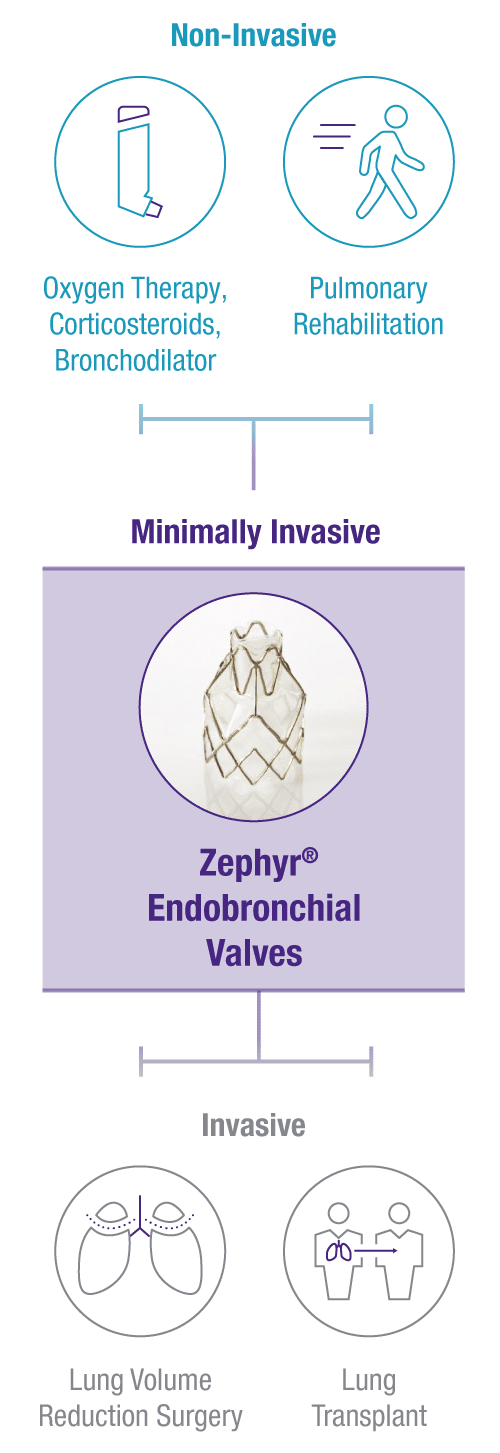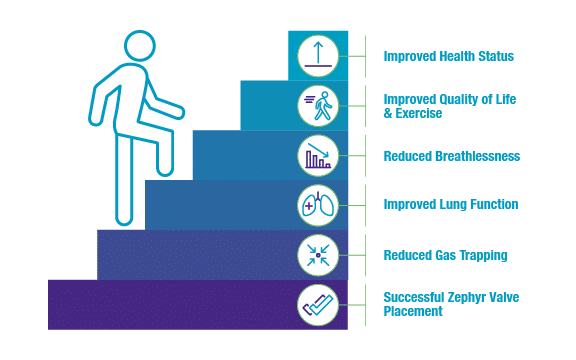Learn How the Zephyr® Valve May Help You
Answer a few questions to see if you may be eligible
Learn How the Zephyr® Valve May Help You
Answer a few questions to see if you may be eligible

Learn How the Zephyr® Valve May Help You
Answer a few questions to see if you may be eligible
Medication and Surgery Are Not the Only Options to Treat Severe COPD and Emphysema
When you take your medications but still have shortness of breath, it may be time to talk to your doctor about the Zephyr Valve treatment — a minimally invasive procedure to help improve your breathing and quality of life. It is a minimally invasive procedure that is completed in about an hour. The valves are placed by bronchoscopy which requires no incisions or cutting, so the benefits are achieved without many of the risks of traditional surgical options.

Ready to Speak with a Zephyr Valve Treating Doctor? Find an Assessment or Treatment Center.

Zephyr Valve Treated Patients Were Found to1:
- Breathe easier and have improved lung function
- Be able to do more exercise and walk further
- Be able to do more daily life activities, such as walking, bathing, and gardening
- Enjoy a better quality of life with more energy
- Feel more confident leaving their home
See How the Zephyr Valve Works
Patients with severe COPD/emphysema often suffer from shortness of breath caused by air being trapped in the lungs, also called hyperinflation.
The Zephyr Valve reduces lung hyperinflation by allowing trapped air to escape and prevents new air from entering the diseased lobe. This allows the healthier parts of the lung to function better and results in patients being able to breathe more easily and experience less shortness of breath.1
Potential complications of the Zephyr Valve treatment can include but are not limited to a pneumothorax (tear in the lung), worsening of COPD symptoms, hemoptysis, pneumonia, and, in rare cases, death.1
Do you have questions about the Zephyr Valve? Call our Care Team.
Monday to Friday, 7 a.m. to 6 p.m. Central Time
Potential complications of the Zephyr Valve treatment can include but are not limited to a pneumothorax (tear in the lung), worsening of COPD symptoms, hemoptysis, pneumonia, and, in rare cases, death.1
More Than 40,000 Patients Globally Have Been Treated with Zephyr Valves
US-EN-1017-v4



 If you do not see an email from “Val at Zephyr Valve” in your inbox within 15 minutes of signing up, go to your “Spam” folder within Gmail. (You may have to click "More" to see the Spam folder.) Select the email from "Val at Zephyr Valve."
There will be a gray box at the top that says “Why is this message in spam?” Click the “Report Not Spam” button. This will move the email to your inbox.
If you do not see an email from “Val at Zephyr Valve” in your inbox within 15 minutes of signing up, go to your “Spam” folder within Gmail. (You may have to click "More" to see the Spam folder.) Select the email from "Val at Zephyr Valve."
There will be a gray box at the top that says “Why is this message in spam?” Click the “Report Not Spam” button. This will move the email to your inbox. Go back to your inbox and open the email. Click on the icon next to “Val at Zephyr Valve”, you’ll see a person icon with a “+”. Click that, and you can add Val to your Contacts list. If you don’t receive a second email from us in a few days, please check your Spam folder again.
Go back to your inbox and open the email. Click on the icon next to “Val at Zephyr Valve”, you’ll see a person icon with a “+”. Click that, and you can add Val to your Contacts list. If you don’t receive a second email from us in a few days, please check your Spam folder again.
